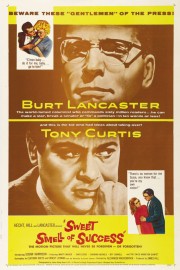Sweet Smell of Success
“Sweet Smell of Success” takes the themes and style of film noir, and inserts them into the world of publicists, columnists, and musicians. It’s a great fit, because someone like J.J. Hunsecker can break a man or woman’s life as easily as a life of crime can, and even more so, because- in the world of gossip columnists- public perception is as much a death sentence as the specter of the police finding out you committed a crime. In how he brings the screenplay by Clifford Odets and Ernest Lehman to life, director Alexander Mackendrick creates a film as seedy as something like “Detour,” but as polished cinematically as the neo noir of later films like “Chinatown” and “L.A. Confidential.” What connects this with those films is its exploration of power dynamics, the wielding of that power, and the way one person’s actions can doom multiple people.
The exceptional thing about Mackendrick’s storytelling in this film is how he builds to Hunsecker before we see him, as personified by Burt Lancaster. The main character in the film is Sidney Falco, a press agent played by Tony Curtis. We begin the film following Falco around as he is fanning the flames for Hunsecker, as well as trying to put out fires Hunsecker’s column on Broadway has started. For Falco, there is such a thing as bad publicity, but if he wants to get some good publicity for his own clients, he realizes he has to play Hunsecker’s game. In this particular case, Falco is to try and break up the relationship between Husecker’s sister, Susan (Susan Harrison), and a jazz guitarist (Martin Milner). Why? J.J. is overly protective of Susan, and even though the guitarist is an up-and-coming star, J.J. would rather put his power to use than see his sister happy.
The film’s style is created by a big band-sounding score by Elmer Bernstein, which has the composer working in a jazzy mode that works for noir, but also captures a seedy side to the Big Apple which Hunsecker and Falco operate in. Visually, this is achieved by the great cinematographer, James Wong Howe, with black-and-white images that emphasize close-ups and empty spaces around the characters, showing how the film takes place in a moral vacuum. With the film’s use of images and music, I wonder whether Orson Welles took any inspiration from this for his own noir about corruption and abuse of power, “Touch of Evil.”
This is an era of filmmaking that I’m still digging into, but starting to see more of actors such as Lancaster and Curtis, it’s interesting to see how filmmakers have worked with them to project different things. For Curtis, this was his breakthrough on screen, and it’s a role that gives the actor a lot to play, whether it’s smarmy lecherousness like he’ll work into “Some Like It Hot” or nobility like “Spartacus” and “The Black Shield of Falworth,” Curtis gives us a lot to chew on. Counter to him is Lancaster, who is all about cynically controlling a situation, and is only concerned about his sister’s well-being in as much as it reflects his view of what her life should be. Mackendrick’s film is a film about the desire to have power over the lives of others, and what it can do for those who wield it, and those it is used against. This film could only work as noir, because nothing good comes from the world these people inhabit.










